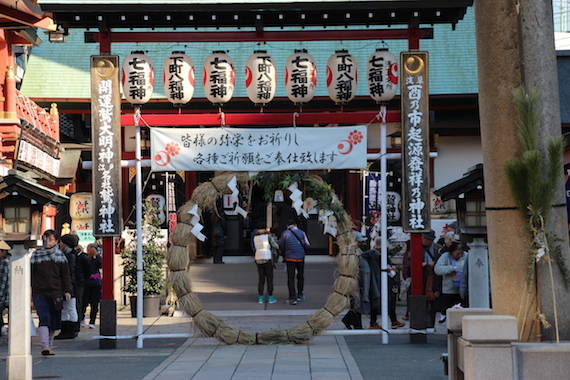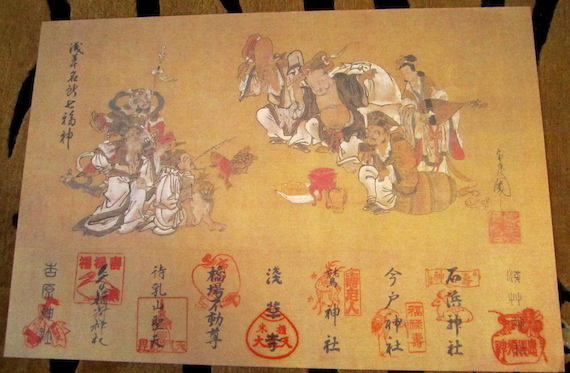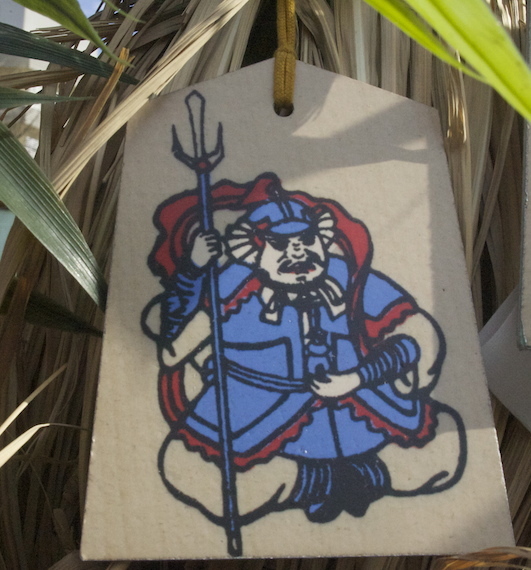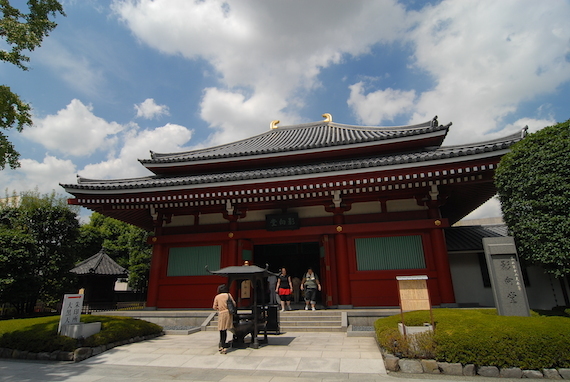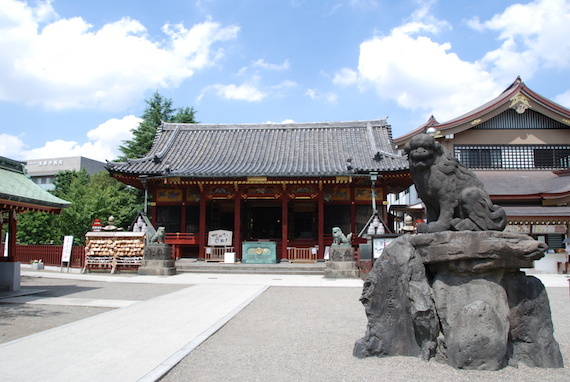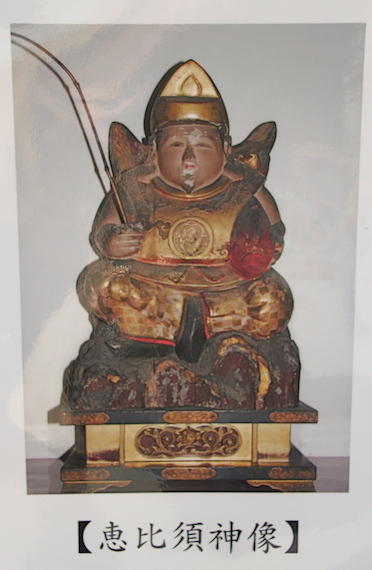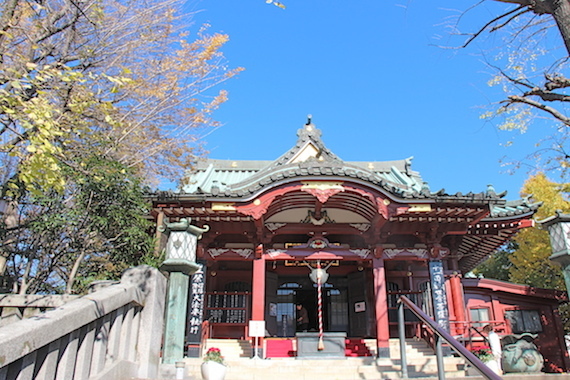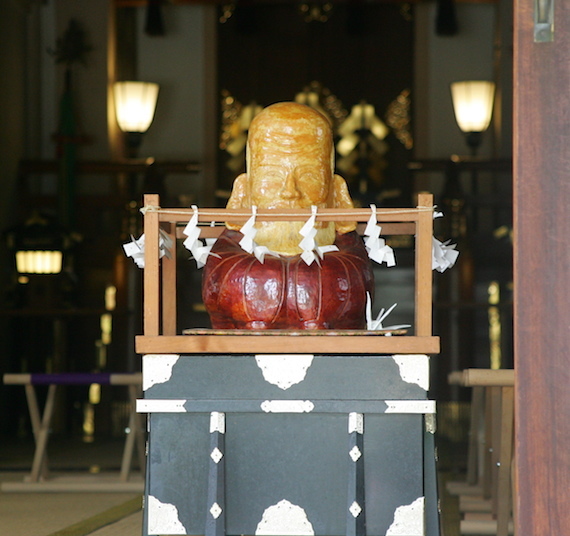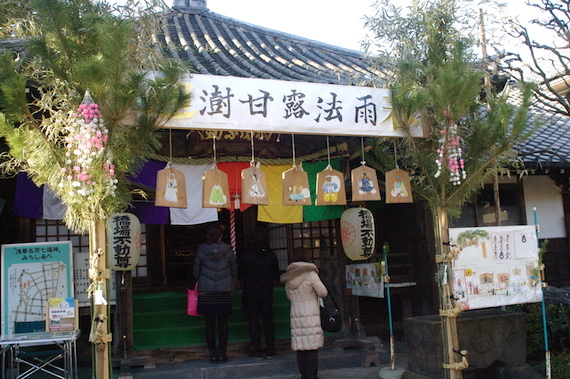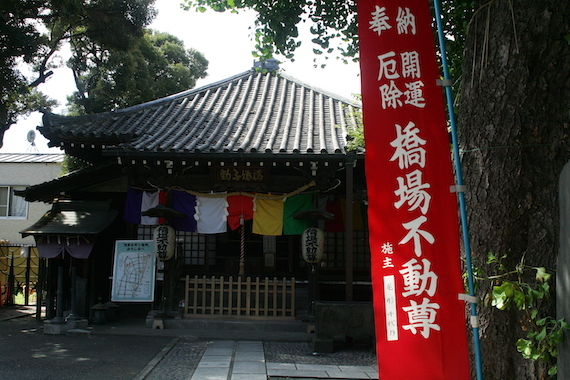In Japan, there is nothing unnatural about the supernatural. Lucky directions, lucky colors, lucky animals, lucky objects, lucky shrines and temples, lucky charms, lucky days, and unlucky days can play a part in decisions large and small, corporate or personal. Don't let that shiny, modern exterior fool you. The Japanese are a people in love with luck.
A lucky circle of branches is set up at some Shinto shrines. Worshippers walk through in a special series of movements that draw off any lingering bad luck. Photo by Gail Nakada.
The Seven Gods of Good Luck play an important part in Japan's love of luck. These deities made their way from India and China along the Buddhist trail with one Japanese Shinto Kami (god/spirit) thrown in for good measure. Some are found at Shinto shrines, others at Buddhist temples. They all get along just fine in that unique Japanese version of religious egalitarianism.
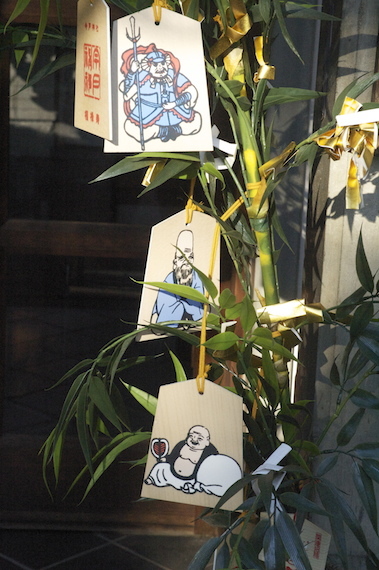
Wooden charms of three of the Seven Gods of Good Luck. Japanese collect all seven and hang them in their home or office. Photo by Gail Nakada.
You see the seven everywhere, often gathered together on a treasure ship, takara bune, helping believers sail off into a brighter future. If they are new to you, here they are with a few of their most common attributes:
Jurojin: God of Longevity.
Benten: (also called Benzaiten), Goddess of Beauty, Art, Music, and Literature/Knowledge.
Bishamonten: God of Warriors (and also treasure). Always fully outfitted in his armor.
Hotei: God of Abundance and Good Health. He will be familiar to many westerners as the fat and happy Hotai.
Ebisu (the only purely Japanese one): God of Fishermen and Merchants and Good Fortune. He is pictured with a fishing pole and dancing red sea bream on the line.
Daikoku: God of Wealth and Commerce and also the Household. Rice represented wealth in old Japan and he is shown standing on bales of the grain.
Fukurokuju: God of Happiness, Wealth, and Longevity (a trait he shares with Jurojin).
These gods are associated with temples scattered all over the country. Asakusa is one of the few places that has all seven are represented in shrines and temples in one general area. Thousands of Japanese make a pilgrimage on this easy-to-follow trail collecting a large embellished 'stamp' of good luck at each one on a beautiful scroll.
The scroll is called Fukuei (foo-koo-ei) and costs around 800 yen. Now, I'm not saying that this scroll will bring you luck.This is just for entertainment and education. However, a completed scroll makes a beautiful and unique souvenir of a trip to Japan and gives visitors a real feel for Japanese folk culture. A culture that is still very much a part of everyday life.
Although the first week of January is the most festive time to go on this lucky quest, locals and visitors follow the trail all year long. If you decide to go on the good luck trail, put your name on the back of the fukuei after you buy it. Each stamp costs 500 or 600 yen. Just wait your turn to show your scroll at the shrine/temple shop and they will know you wish to have it stamped. Pay the fee and wait as a priest carefully stamps it.
According to tradition, each god oversees a specific set of attributes with a lot of overlapping. Depending on your timetable and the state of your feet, visitors don't have to stop at every one. Just pick your own 'Lucky God Adventure' and go for it.
The easiest place I've found to get started and pick up your scroll and the first stamp is Otori Jinja. They have the scrolls prominently displayed at the shrine's little shop. Just point. From Otori Jinja it is just a short walk to the shrine for Benten, the Goddess of Knowledge, Art, and Creativity. Once you have these two stamps, you can head back to Asakusa and concentrate on the rest of the shrines and temples clustered around Asakusa Station.
Otori Jinja: Get your Jurojin, God of Longevity, stamp.
Shinto Otori Jinja is just bursting with luck. At the entrance, the priests have gathered dozens of auspicious symbols displayed on a giant Kuma no De (bear paw rake) to 'rake in' all things bright and bountiful.
The central offering box is made of a giant smiling lucky maiden's face carved from cedar. The 'Nade Okame' (mask you rub) beams at all who make their way to the altar. Rub her eyes to become more insightful; forehead to become clever; her nose for money luck; her right cheek to find your soul mate; left cheek to become healthy; her mouth to protect from bad luck; and, lastly, from her chin, run your hand around her face in a clockwise motion to make your life go smoothly!
Even though he is not prominently displayed in the sanctuary, Jurojin, the God of Longevity and Wisdom, is enshrined here. This is important because you want a nice long run for your good fortune.
Pick up your Fukue and stamp at the shop. They also sell a small, painted, wooden charm of Jurojin for just 300 yen. These little wooden charms are another feature of the Seven Gods Trail. Instead of stamps, some people collect the charms to display on a plastic bamboo branch.
Access: Ten minutes from Iriya Station, Hibiya Metro line. Exit 4. At the top of the stairs, go straight ahead to the next traffic signal. Right at the intersection, then straight for two lights. Otori Jinja is at the big intersection in front of you. The shrine is wheelchair accessible. Coming from Asakusa? Take a taxi.
Yoshiwara Jinja: Get your Benten, Goddess of Beauty and Art, stamp.
Just a short way from happy-go-lucky Otori Jinja is Yoshiwara Jinja, a Shinto shrine dedicated to Benten, the Goddess of Beauty, Music, Literature and Art. Benten is especially revered by women, and it is only appropriate her shrine stands right in the middle of the old Yoshiwara red-light entertainment district.
For centuries, this area bustled with brothels, streetwalkers, tea houses, and gambling places. Though the traditional wooden architecture is long gone, the area is still alive with private "clubs" staffed by over-dressed (and over-oiled) doormen on the back streets.
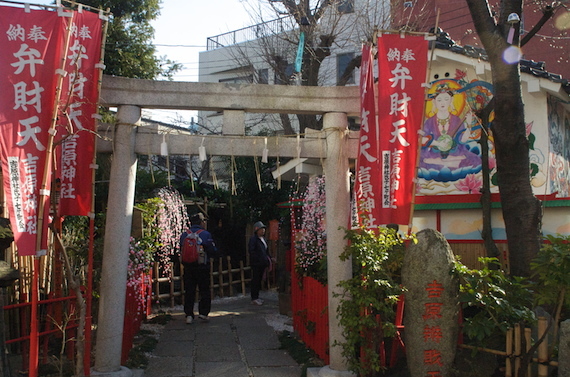
Benten's shrines always have or are near a well or water feature as she is the goddess of all that flows. By Gail Nakada.
Benten started out as a Hindu goddess who has been transformed into a Shinto deity with a sideline in Buddhism. Japanese are flexible that way. Since goings-on in Yoshiwara were not of the most honest nature, perhaps worshippers preferred the fact that the Shinto religion has almost no fiery concept of hell and damnation.
The shrine is simple and colorful. Shrines to Benten always include a water feature, preferably a well or natural spring, since another way to describe her is the 'goddess of all that flows'. Benten's well is actually in a separate shrine very nearby.
Access: With Otori Jinja's torii gate at your back, go left and walk to the next traffic light. Turn left and left again. Benten's well is on the right, a few yards down the street. The colorful shrine is a little further on your left. No stairs.
Back in Asakusa, two of the best known lucky gods are right on the grounds of Sensoji Temple, a place all visitors want to go to anyway. How lucky is that?
Yogoda Hall, Sensoji Temple: Get your Daikoku, God of Wealth, stamp.
On the other side of Sensoji's iconic red lantern and a little to the left of the main hall, is the secluded compound of the black Daikoku, one of the city's most auspicious symbols.
Daikoku is the happy guy with the magic treasure hammer and a big bag of goodies slung over his shoulder. God of Commerce, Agriculture, and Wealth. The koku part of his name actually means 'black' and is the birthright of his Hindu/Shiva origins though he is almost never depicted in that color. One reason this statue is so rare.
Daikoku stands inside the Yogoda Hall, the large red building directly in front of you, behind the big metal incense burner.
This new temple also houses statues of seated Buddhas who follow the teachings of Kannon, the Bodhisattva of mercy and benevolence. People pray to the individual Buddha that conforms to their Chinese zodiac animal. (If you don't know yours and want to, just search for 'Chinese zodiac animals' online.)
As you enter, the statue of Daikoku is on your left. Photographs are not allowed, so behave. This Daikoku is considered especially powerful for property and real estate.
Access: The same as Sensoji from Asakusa Station. Asakusa Station, Ginza Metro Line. Take Exit 1 to street level. At the busy street, go straight ahead with the exit at your back. Walk about ten yards to the Kaminarimon (thunder gate). This is the first gate to Sensoji. Go through and along the Nakamise shopping promenade to the second gate. At Sensoji Temple, go along the left side of the main hall. You will see a decorative stone bridge on the left and a bright red building with a bronze incense burner in front. That is Yogoda. There are several stairs; it is not easily wheelchair accessible.
Asakusa Jinja: Get your Ebisu, God of Luck, stamp.
Japan has a relaxed attitude toward religions. Up until the middle of the nineteenth century, Buddhist temples and Shinto shrines often shared the same grounds and, sometimes, even doctrine.
You can still see this at Asakusa Jinja. This Shinto shrine, complete with torii gate and fluttering white purification banners, stands on the grounds of Sensoji temple just to the right of the main Buddhist hall. The shrine was built to deify the three men who found the Kannon statue that Sensoji is built around.
The interior of the shrine building is magnificently decorated with brightly painted panels of mythical beasts, carved statues of long dead warriors and lots of artful architectural details.
This shrine is where you get your stamp of Ebisu. Ebisu is another happy, smiling fellow often paired with Daikoku and on everyone's list of deities they want on their side. He is the God of Fishermen, Merchants and Luck, the one with the fishing pole and big sea bream dancing on the line. He is also the only purely Japanese member of the group.
The lucky Ebisu statue at Asakusa Jinja. You just have to take it on faith he is there! Photo of a photo (LOL) by Gail Nakada.
At the shrine, a statue of Ebisu is nowhere in sight. As famous as this trail of luck is - and you'll see maps in Japanese all over the area illustrating the route or pointing out your current pilgrim's progress - not every shrine/temple puts the god out for everyone to see.
Asakusa Jinja's Ebisu is considered too powerful and too rare to be displayed except as a photograph. The real statue is kept locked away in a holy place deep within the building. Not even making a public appearance at New Year's.
"But," we ask, "how will our prayers be heard when we can't see him?"
"Have faith," one of the priests answered.
Oh. Right.
Access: With the steps of towering Sensoji's main building in front of you, Asakusa Jinja is just ten or twenty yards to your right. To get your stamp, go to the shrine's shop to the right of the altar and lion dog.
Matsuchiyama Temple: Get your Bishamonten, God of Warriors and Wealth, stamp.
If you're looking to become wealthy, Matsuchiyama should definitely be on your list. Bishamonten is the aggressive looking guy in armor, the God of Warriors. He is also associated closely - and unashamedly - with treasure. Lots of it. After all, money is so often the catalyst for war.
At this large stone and wood temple, it is all about the money. Just look around. Statues, tiles and carvings of kinchaku, golden moneybags, are repeated everywhere on the temple grounds. Even the large cisterns on either side of the main shrine are shaped like giant bags of loot. Roof tiles carry the theme up and over the temple itself.
You can pretty much guess what everyone prays for when they come here.
Money, money, money... Kinchaku, moneybags, are an important decorative feature of Matsuchiyama. Photo by Gail Nakada.
There has been a temple on this sacred hill for 1400 years. In addition to money bags, you'll also see two crossed white daikon radish carved and painted in roof tiles and in forged bronze around the temple grounds. Some visitors like to interpret the daikon motif in crude ways, but actually, they symbolize personal and family relationships and health. At the New Year, some Shinto shrines in the countryside give visitors a white radish as a symbol of health and plenty. Visitors take the radish home and prepare it with their meal, thereby ingesting all the lovely goodness from the shrine.
Access: Its full name is Matsuchiyama Honyudo. It is on busy Edo Dori boulevard. Take Exit 7 from Asakusa station. Edo boulevard runs along the Sumida river. Facing the street, go to the left. Walk for about 15 minutes. Matsuchiyama is almost opposite the baseball field on your right. You'll see the greenery. Go up the stone steps. No ramps, no elevator. Not wheelchair friendly.
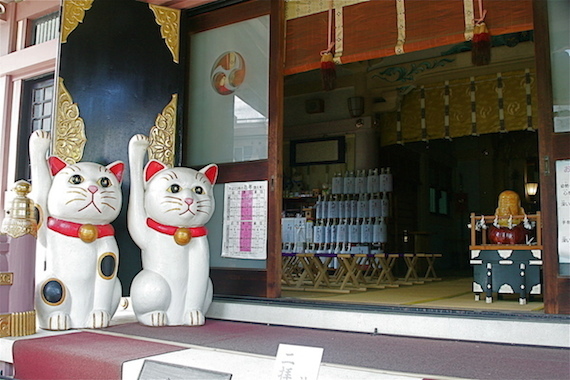
Imado Jinja's lucky cat couple with the staute of Jurojin. One stop for love and long life! Photo by Gail Nakada.
Imado Jinja: Get your Fukurokuju, God of Knowledge and Long Life, stamp.
Imado is best known for its legendary powers as a love shrine. The shrine's iconic maneki neko (beckoning lucky cats) have become symbols of enduring love and busloads of Japanese come to pray for constancy in their lover or a lover-to-be. Many visitors, though, make their way specifically to the shrine's other deity: Fukurokuju, the God of Luck (particularly for your offspring and property) and Longevity.
A shiny carving of the big headed, grinning elderly man seated on a brightly colored cushion is on display at Imado's main altar to the right of their famed lucky cats. It's a rather strange pairing, Jurojin and love. You'd think a goddess would do the honors. But maybe the priests are right. Benten is often associated with knowledge, and, if we were really smart, none of us would fall in love.
Access. From Matsuchiyama Temple, go back to the main street and left about two very short blocks. The first temple with the fierce guardian statues is not Imado! Keep going to the big torii gate on the left. The main altar is at the top of a set of stairs and not wheelchair accessible. However, the sanctuary is plainly visible from the ground, so don't let that deter you if someone in your group is mobility impaired.
Hashiba Fudosan: Get your Hotei, God of Happiness, stamp.
Hotei, often called Hotai in the West, is the jolly fellow with the big belly. Of all the temples on this list, his is the only real disappointment. Except during January when it is decorated for the holiday season and full of people on the Seven Gods trail, the temple is small and plain. Hotei's image stays locked away in a vault.
They do have Hotei charms, quite an assortment, but if you are not there during festival season, you need to ring the doorbell on what looks like a house (it is, actually. This is the home of the priest and his family). Wait for the attendant to answer. Don't worry; they expect people to do this.
Hashiba Fudosan is plain and unadorned most of the year. For such a happy god, you think they could make the place a bit more cheerful. Photo by Gail Nakada.
Access: With Imado Jinja's torii gate at your back, walk to the left, away from Asakusa Station and the way you came. You'll finally pass a Lawson's convenience store. The temple is just a few steps beyond that where you see the red flags fluttering.
Too many choices and too little time? Here's what we would do. Start with Otori Jinja where it's easy to pick up the scroll and your first stamp. Go to Benten's shrine less than two blocks away. Grab a cab for Sensoji Temple and Yogoda Hall's Black Daikoku (real estate luck and good fortune). Then walk to Asakusa Jinja for Ebisu (good fortune). Walk, or cab it to Imado Jinja (longevity with a sweet side dish of love).
That's enough luck for anybody!

